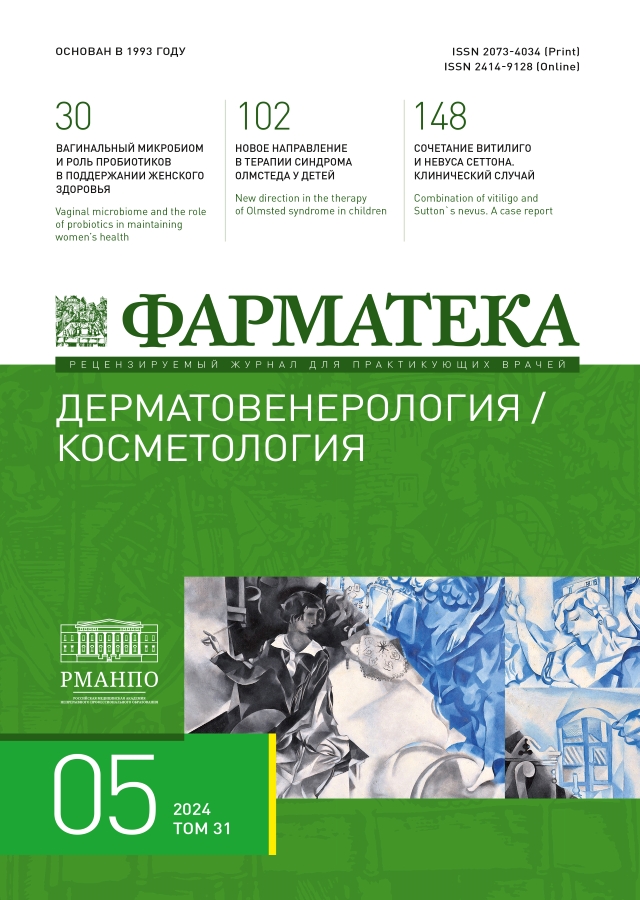Experience of using a lactose-free diet in a patient with seborrheic dermatitis
- Авторлар: Svechnikova E.V.1,2, Maksimova Y.V.3, Arutyunyan G.B.4, Artemyeva N.O.5, Devyatova A.V.5
-
Мекемелер:
- Russian Biotechnology University
- Polyclinic No. 1 of the Administrative Directorate of the President of the Russian Federation
- Novosibirsk State Medical University
- Pirogov Russian National Research Medical University
- Expert Multidisciplinary Clinic OMNIUS
- Шығарылым: Том 31, № 5 (2024)
- Беттер: 153-155
- Бөлім: Clinical case
- URL: https://journals.eco-vector.com/2073-4034/article/view/639881
- DOI: https://doi.org/10.18565/pharmateca.2024.5.153-155
- ID: 639881
Дәйексөз келтіру
Аннотация
Seborrheic dermatitis (SD) is a chronic relapsing multifactorial skin disease characterized by increased secretion of sebum, changes in its qualitative composition and localization in the area of accumulation of sebaceous glands. Modern methods of treating SD do not provide stable long-term remission, which requires the expansion of standard approaches to the treatment of the disease. The etiology of the disease is currently an object of study, and any exogenous factor can serve as a trigger - stress, neuroendocrine disorders, improper care, deficiency states. In the literature, relationship between the development of the disease and the activation of yeast-like fungi Malassezia spp., genetic features of sebaceous gland secretion, immunodeficiency states, as well as zinc and nicotinic acid deficiency is the most frequently described. In addition, functional gastrointestinal symptoms are quite common among patients with SD, and their diagnosis and treatment is a complex clinical problem. This article describes a clinical case of successful therapy of a patient with a protracted course of SD using a lactose-free diet.
Негізгі сөздер
Толық мәтін
Авторлар туралы
E. Svechnikova
Russian Biotechnology University; Polyclinic No. 1 of the Administrative Directorate of the President of the Russian Federation
Хат алмасуға жауапты Автор.
Email: elene-elene@bk.ru
ORCID iD: 0000-0002-5885-4872
Dr. Sci. (Med.), Professor at the Department of Skin and Sexually Transmitted Diseases, Russian Biotechnological University; Head of the Department of Dermatovenereology and Cosmetology, Polyclinic No. 1 of the Administrative Directorate of the President of the Russian Federation
Ресей, Moscow; MoscowYu. Maksimova
Novosibirsk State Medical University
Email: elene-elene@bk.ru
Ресей, Novosibirsk
G. Arutyunyan
Pirogov Russian National Research Medical University
Email: elene-elene@bk.ru
ORCID iD: 0000-0002-9454-0854
Ресей, Moscow
N. Artemyeva
Expert Multidisciplinary Clinic OMNIUS
Email: elene-elene@bk.ru
ORCID iD: 0000-0002-5619-6757
Ресей, Moscow
A. Devyatova
Expert Multidisciplinary Clinic OMNIUS
Email: elene-elene@bk.ru
ORCID iD: 0000-0003-0498-2673
Ресей, Moscow
Әдебиет тізімі
- Karyakina L.A., Kukushkina K.S., Karjakin A.S., Bogdanov Yu.A. Seborrheic dermatitis: the role of the microbiota of the skin and intestines. Med Theory Pract. 2020;4(1).
- Sampaio A.L., Mameri A.C., Vargas T.J., et al. Seborrheic dermatitis. An. Bras. Dermatol. 2011;86(6):1061–71; quiz 1072-4. English, Portuguese. doi: 10.1590/s0365-05962011000600002.
- Borda L.J., Wikramanayake T.C. Seborrheic dermatitis and dandruff: a comprehensive review. J Clin Invest Dermatol. 2015;3(2):10–8. doi: 10.13188/2373-1044.1000019.
- Dessinioti C., Katsambas A. Seborrheic dermatitis: etiology, risk factors, and treatments: facts and controversies. Clin Dermatol. 2017; 35(4):393–401.
- Олисова О.Ю., Давидович М.И. Современные подходы к себорейному дерматиту. Фарматека. 2018;4:7–12. [Olisova O.Yu., Davidovich M.I. Modern concepts of seborrheic dermatitis. Farmateka. 2018;4:7–12. (In Russ.)]. doi: 10.18565/pharmateca.2018.s5.7-12.
- Schwartz R.A., Janusz C.A. Seborrheic dermatitis: an overview. Am Family Physician. 2014;90(6):419–26.
- Park S.Y., Kwon H.H., Min S.K. Clinical manifestations of seborrheic dermatitis according to age. J Eur Acad Dermatol Venereol. 2018;32(11):1943–49.
- Marenholz I., Esparza-Gordillo J., Rüschendorf F., et al. Meta-analysis identifies seven susceptibility loci involved in the atopic march. Nature Communicat. 2015;6:8804. doi: 10.1038/ncomms9804.
- Shi N., Li N., Duan X., Niu H. Interaction between the gut microbiome and mucosal immune system. Military Medical Research. 2017;4:14. doi: 10.1186/s40779-017-0122-9.
- Rudzeviciene O., Narkeviciute I., Eidukevicius R. Lactose malabsorption in young Lithuanian children with atopic dermatitis. Acta Paediatr. 2004;93(4):482–86.
- Клинические рекомендации. Себорейный дерматит. 2022-2023-2024 (11.07.2022). [Clinical guidelines. Seborrheic dermatitis. 2022-2023-2024 (11.07.2022). (In Russ.)].
- Полеско И.В., Малиновская В.В. Роль микрофлоры кожи и кишечника у больных себорейным дерматитом. Детские инфекции. 2005;1:39–44. [Polesko I.V., Malinovskaya V.V. The role of skin and intestinal microflora in patients with seborrheic dermatitis. Detskiye infektsii. 2005;1:39–44. (In Russ.)].
- Deng Y., Misselwitz B., Dai N., Fox M. Lactose intolerance in adults: biological mechanism and dietary therapy. Nutrients. 2015;7(9):8020–35. doi: 10.3390/nu7095380.
- Nogueira M., Gomez-Garcia F., Ramos L., Hermoso M. Milk intolerance and skin diseases. Foods. 2019;8(6):213.
- Bodo C., Ehrchen J., Hagemann T., et al. Lactose intolerance and skin diseases. Int J Dermatol. 2014;53(12):1467–74.
- Skroza N., Tolino E., Semyonov L., et al. Mediterranean diet and familial dysmetabolism as factors influencing the development of acne. Scand J Publ Health. 2018;46(8):797–800.
- Абатуров А.Е., Никулина А.А., Демиденко Ю.В. Клиническое значение избыточного содержания лактозы в диете (часть 1). Здоровье ребенка. 2016;1(69):104–9. [Abaturov A.E., Nikulina A.A., Demidenko Yu.V. Clinical significance of excess lactose in the diet (part 1). Child health. 2016;1(69):104–9. (In Russ.)].
Қосымша файлдар








